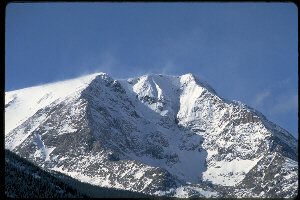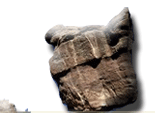Rocky Mountain National Park

Rocky Mountain National Park is located in north central Colorado. Its gateway cities are Estes Park on the east and Grand Lake on the west."Rocky" is one of the premier destinations for visitors to Colorado, and hosts over 3 million visitors every year.
The park is noted mainly for its scenery, especially Trail Ridge Road, a 48 mile
stretch of US 34 from Estes Park to Grand Lake in some of the world?s most spectacular mountain scenery. The park
is also noted for its wildlife. A favorite autumn pastime of the locals is listening to the bugling of the elk.
For the best luck finding watchable deer, bighorn sheep and elk, try
Horseshoe Park or Moraine Park near sunrise or sunset. These "parks" were once deep glacial lakes, the
last stop for the rivers of ice that carved the Rocky Mountains from a high plateau. Today, the former lakes are
large open meadows, surrounded by forested moraines and carpeted with alpine wildflowers, and mountain streams
run through them, teeming with trout just waiting for the right fly.
Sheep Lake is a natural salt lick in Horseshoe Park that attracts Rocky
Mountain bighorn sheep that come down from the high crags. To reach the lick, the bighorn have to cross Trail Ridge
Road. With luck, you'll happen along when the bighorn are crossing the highway, or when they're grazing around
Sheep Lake. Unhappily, seeing bighorn these days is pretty chancey, as a pneumonia epidemic killed almost 90% of
the herd in the winter of 1993-94.
Even if you miss the bighorn you'll still have good views of the Continental
Divide and Mounts Chapin and Ypsilon in the Mummy Range, especially at sunrise, when Alpenglow turns the snow fields
pink.
Bear Lake, about 20 minutes drive from Horseshoe Park on Bear Lake Road,
may be Rocky's most visited feature after Trail Ridge. Heavy traffic to Bear Lake is assuaged with a shuttle bus
service. You can catch the bus at several marked parking lots along the Bear Lake Road. Bear Lake is the highest
alpine lake accessible by paved highway in the Rocky Mountains range. A mile long path around the lake yields a
variety of views of Longs and Hallets Peaks and Glacier Gorge.
Several popular trails into the back country commence at Bear Lake, including
the Flattop Mountain Trail, which leads to Grand Lake, and includes a 3,000-foot elevation gain. Plan on a minimum
of two days one way to make this hike. You'll need a shuttle unless you want to walk both ways. Most people seem
satisfied after a one-way trip.
Everybody who feels like they have something to prove wants to climb
Longs Peak, at 14,555 feet the highest peak in Rocky. Accessed from Wild Basin in the southeast corner of the park,
the Longs Peak hike is at least a half day undertaking. Experienced folks make the 4-mile backpack into Jim's Grove
(for which you'll need reservations) for an early start, to be sure they're off the mountain before the afternoon
lightning storms. Don't even think about climbing Longs Peak unless you're in top condition and acclimated to high
altitude.
For a different approach to Trail Ridge, try the Fall River Road, the
original highway from Estes Park to Grand Lake. Pick it up from Trail Ridge Road in Horseshoe Park. One way and
unpaved, it's a road less traveled (and less crowded) and affords a different view of Trail Ridge. It follows the
Fall River up to Trail Ridge Road at the Alpine Visitor Center, passing by several waterfalls and cascades along
the way, and provides different perspectives of the peaks. Fall River Road opens late in the season, generally
around July 1.
PLANNING YOUR TRIP
Call Rocky Mountain National Park at (970) 586-1206. For accommodations,
write to the Chamber of Commerce, Estes Park, CO 80517 or Grand Lake, CO 80447.
Trail Ridge Road | Elk Bugling
Trail Ridge Road
Trail Ridge Road is a portion of U. S. Highway 34 that spans Rocky Mountain
National Park. The highway is an easy drive of 48 miles between Estes Park at the east entrance and Grand Lake
at the west. Considered a premier scenic drive (Weissmann Travel
Reports lists it as one of the top three in the world, and it
was selected as one of only six All-American Roads by the Secretary of Transportation in 1996), it provides the
traveler in a hurry the opportunity to sample the delights of the Rockies in just a few hours.
Forest Canyon on one side, Fall River Canyon on the other, Trail Ridge
Road snakes over Trail Ridge, a remnant of the high plateau that gave birth to the Rocky Mountains. With more than
11 miles above treeline, it's the highest continuous highway in the country. Not your charming tree-lined boulevard,
this highway offers unobstructed views of some of the world's most rugged scenery.
The obvious feature of Trail Ridge is a tortured, glacier-carved landscape
dominated by majestic, sheer-faced peaks that look as if they might have been chisled by the hand of some giant
sculptor.
A second feature, subtle and easily overlooked, is the alpine tundra
over which you're driving. Most of the life above timberline is found on the tundra, the unglaciated plateau. The
peaks, though beautiful, are largely barren.
A casual glance suggests that the tundra is like a Midwestern prairie,
but you'll not grow corn here. An average elevation of over 11,000 feet and fierce winter winds that scour the
ground of all but the hardiest plants create a climate that rivals the Arctic in severity. The ecosystem is unique
in the lower forty-eight and is arguably the most interesting on the planet.
With a growing season that's measured in weeks, life on the tundra is
life on the edge, hardy but fragile. A plant may need years to recover from being walked on.
At the Rock Cut turnout, approximately midway between Estes Park and
Grand Lake, a paved nature trail about a quarter of a mile long leads to an intimate view of tundra life. Some
of the most charming of mountain flowers will be found in the tundra. Depending on your arrival, you may see the
alpine forget-me-not, alp lily, alpine columbine, mountain marsh marigold, mountain candytuft, alpine wallflower,
tall chiming bells, fairy primrose, and the lovely harebell, the true bluebell of Scotland.
Animal life supported by the tundra includes the golden marmot, a comical
character related to the woodchuck. The marmots are likely to be busy fattening up for a long winter hibernation.
Seeing them waddle about, their thick, glistening fur rippling in the breeze, you may feel that they're already
fat enough.
The tiny pica ("rock rabbits") don't hibernate but build runs
beneath the snow. If one should be scurrying along looking as if he is carrying a load of hay, he is. The pica
harvest grass and store it for the winter. They will whistle warnings upon your approach, but they are used to
people and probably won't bother to hide.
Birds that visit the tundra include the Stellar's jay, ravens, hawks,
and eagles. The Clark's nutcracker will happily snatch treats from a hand held aloft. Ptarmigan pecking among the
rocks are difficult to spot but persistence will be rewarded. Experts at camouflage, the wily ptarmigan are speckled
brown and gray in summer and solid white in winter. They even grow feather "snowshoes" for winter wear.
With luck, you may see elk or the shy Rocky Mountain Bighorn sheep.
The nature trail ends at a large rock outcrop. Its surface is covered
with multicolored lichens arranged in abstract patterns. Deep fissures give testimony to the struggle between water
and stone, between process and inertia, and declare water the winner. On the other side of the rock the Fall River
Canyon may be filled with mist, the peaks of the Mummy Range soaring beyond.
Rocky Mountain National Park | Elk Bugling | Planning
Your Trip
Listening to the Bugling
of the Elk in Rocky Mountain National Park 
Louis Armstrong or Wynton Marsalis, it ain't. Even the kid down the block
blows a better horn. So why do thousands of people make tracks to Rocky Mountain National Park every autumn just
to hear the "bugling" of the elk? A typical autumn weekend evening finds thousands of people crowded
along the Park's roads and trails, enjoying picnics and tailgate parties in the dark while listening to a far out
concert of squeals and grunts.
Although listening is the principal activity, viewing is also on the
program. Starlight is usually sufficient to see the buff shapes of elk in the meadows against the darkness of the
forest, and moonlight is as effective as stage lights.
Autumn is the season for elk, deer and bighorn sheep to celebrate life
in the rituals of the rut. For the listeners, the song of the elk seems to be a channel to reconnect us with our
primeval roots, to awaken ancient racial memories of rituals performed in our own celebrations of life, perhaps
dancing in the moonlight to the throbbing beat of some pagan tomtom.
In late afternoon, as if materializing from thin air, the elk begin to
emerge from the forests into the meadows. Occasionally bugling, the bulls herd harems of cows and yearling calves.
The cows and calves feed. The bulls are too busy with the demands of the rut to bother with mundance activities
such as eating and in the coming winter some of them will pay with their lives for this omission.
The ceremonies of the rut continue until around sunrise, when the elk
will once again melt into the forest for a good day's rest.
While we were hiking on the Cub Lake trail one golden afternoon, we discovered
a small herd, a magnificent bull and his harem of half a dozen cows, in a small clearing near the Big Thompson
River. Near sunset, the eastern slopes of the Rockies were deep in shadow. In the valley, yellow and russet willow
leaves glowed in the last rays of sunlight streaming down Forest Canyon as we joined other hikers quietly gathering
in the clearing.
The bull stood a little way up on a ridge at the edge of the clearing,
where he had a vantage point to watch his harem -- and us. The cows, apparently completely trusting in their master,
placidly stripped leaves from the willows while he stood guard.
While we watched, a pretender to the throne, a younger bull with a year
or so of growth left, ventured into the clearing from the forest behind the harem master. He was obviously aware
of the master. Lucky for the pretender, the master was preoccupied with us and never saw him. The pretender quickly
sized up the situation and after a few suspenseful moments he silently slipped back into the forest. Next year,
he may challenge the master for his harem.
His willie waving like a baton, the bull tilted up his nose, laying his
antlers along his back like wings, and opened his mouth. The bugle was an eerie squeal that gradually rose in pitch
to a peak then abruptly dropped, and ended in a series of three or four grunts. Between bugles the bull attentively
watched the group respectfully watching him. His eyes showed neither fear nor anger but disdain, as if he knew
that we knew that he was in charge and had full control.
The cool of twilight soon deepened into the chill of night as the Harvest
Moon rose from behind the jagged peaks of the Front Range. Bathed in moonlight, his breath condensing in the cold
air like a silver plume, the bull sang his mysterious song. Transfixed, we were engulfed in a flood of bugles coming
from every direction, chorusing in a primeval celebration of the rut.
| Rocky Mountain National Park | Trail Ridge
Road |
| Planning
Your Trip |
| 





